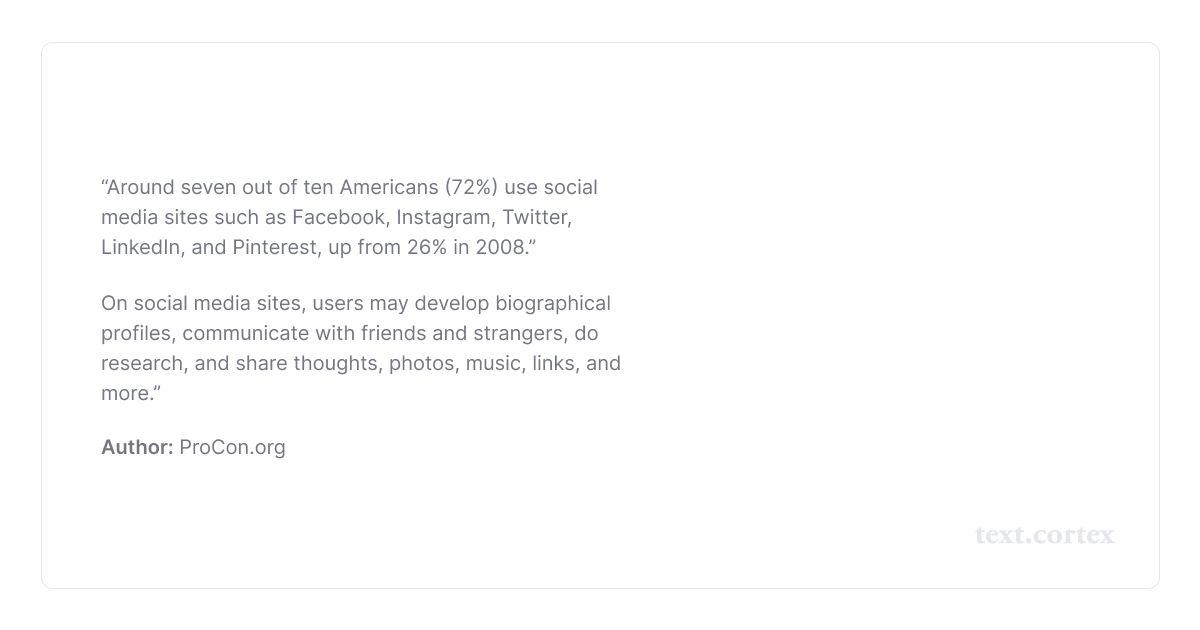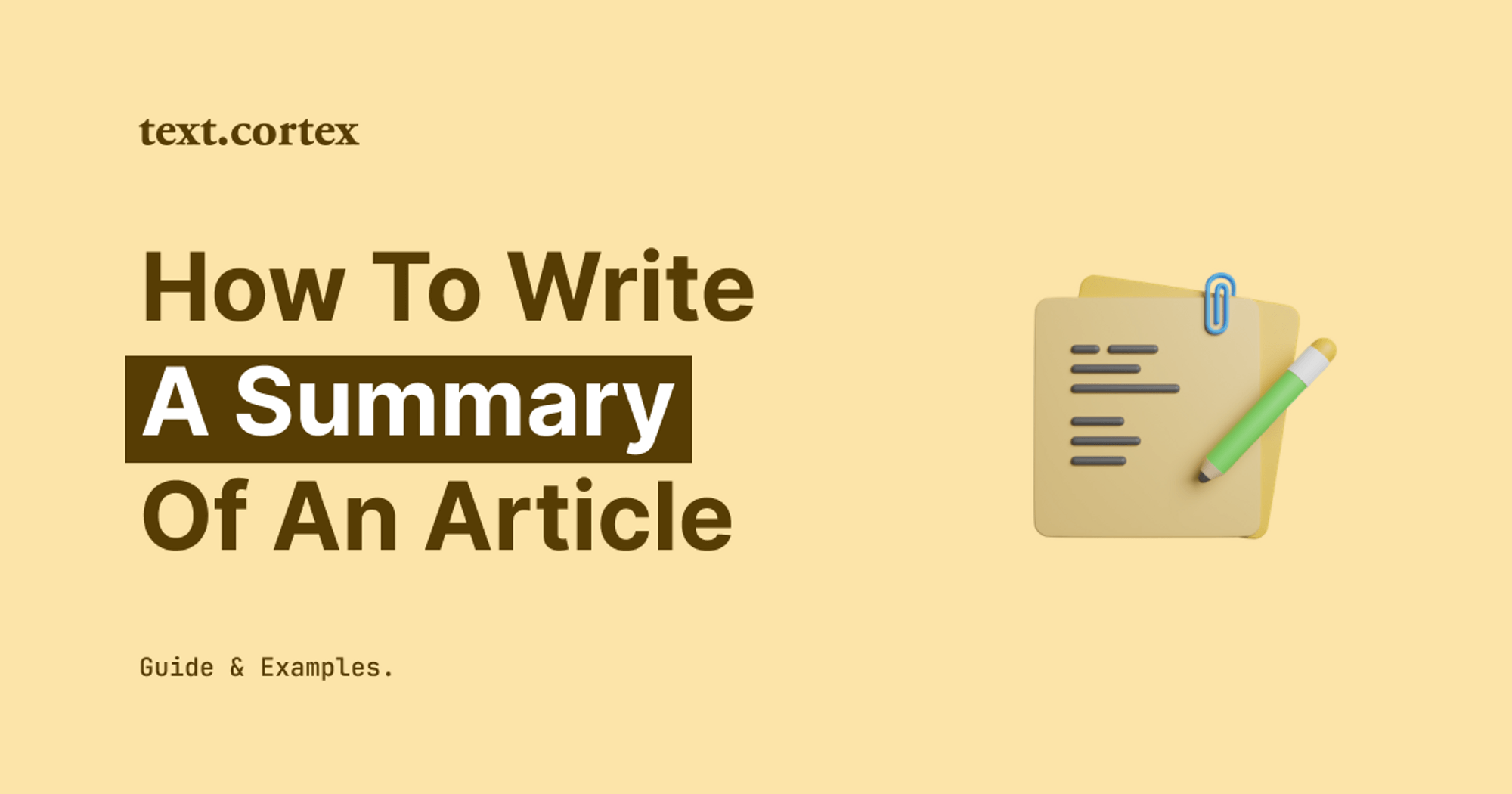Have you ever considered why article summaries yield so much attention online?
And why it matters so much to writers?
It would be demoralizing to pour a great deal of effort and enthusiasm into an article only to have it end in a banal, trite manner.
It's like a well-made film with a vague ending.
A poor summary of an article isn't just detrimental to the piece overall, it can also leave you feeling like your precious time has been squandered.

This post will go over some guidelines on how to summarize an article, such as where to start, what to include, and how to keep it short and interesting.
Moreover, we will offer some tried-and-true solutions that can help you speed up the summarizing process.
But before we get into that, let's figure out why we have to summarize articles in the first place.
Let’s go!
Why Do We Need to Summarize Articles?
When you need to convey the gist of a lengthy article to someone who still needs to read it, a summary is your best bet.
It allows readers to get the brief of an article quickly without having to read it cover to cover. Your readers can easily remember and retain the main points of an article if they are correctly summarized.
What's more, article summaries are a time-saving technique that can be used when:
✅ Writing the last part of an article.
✅ Writing a review of a book.
✅ When getting ready for a presentation in class.
✅ When conducting research for a project.
✅ When getting ready for an interview.
✅ When preparing for a test.
✅ When writing a blog post.
✅ When making a report for a customer.
✅ When writing news summaries for a website.
✅ If you are writing a speech.
Now that you know where to use it, let’s learn how to write a summary of an article in 5 simple steps. .
You’ll be surprised when you discover that you were probably unconsciously using all these techniques already.
How To Write a Summary of an Article In 5 Steps
1. Read The Article
The first step in writing a summary of an article is, of course, to read the article carefully.
Even though this step might seem obvious, you might be surprised by how many people think a quick overview is all they need to understand a concept fully.
That may be true, but if you want people to take your summary seriously, take the time to read the article carefully and pay attention to the main points, its details, and the structure of the text.
That way, you can ensure you're covering the essentials of the article, which serve as your summary's backbone.
2. Identify The Main Ideas of The Article
Let’s not beat around the bush: a quick glance at the article's outlines will reveal its central arguments.
Outlines of articles emphasize everything of utmost importance for the subject at hand.
However, if the article doesn’t have outlines, you can extract the main ideas by looking for the topic sentence in each paragraph.

3. Write Your Understanding of The Topic
The third step in writing a summary of an article is to write its main points in your own words.
The question you should ask yourself when you write an article's summary is this:
🎯 What are the most important points that your readers should remember?
At this point, you are free to use more than just a simple statement.
Think about the big picture and focus on conveying the general impression of the argument.

Your summary argument can be more convincing by including specifics directly connected to the main idea.
4. Define Your Thesis Statement
Now that you've laid out your arguments, what do you think of your findings as a whole?
The summary boils down to your assessment.
🎯 What is the bottom line message you are trying to convey?
Unfortunately, there is no silver bullet for putting your ideas into words, therefore we are limited in the advice we can provide you.
Just be yourself when you write it — your audience will enjoy the authenticity and originality that comes from your voice.
If a reader doesn't care about what he just read, that's the worst possible reaction, right?
Thus, whether they agree or disagree, you've accomplished your goal as a writer if your audience is engaged with your content.
5. Rewrite The Summary
Once you've completed the four steps outlined above, you have your first draft of the summary, which needs additional tweaking to make it coherent and effective.
To successfully summarize an article, you will need to rewrite it (either the entire output or just fragments of it) to strengthen your context.
You can get the most out of your sentences by using a rewriting technique that primarily focuses on shifting the working order and experimenting with synonyms.
The following are the essential components of powerful sentences:
🎯 They are clear and easy to read.
🎯 They maintain a consistent and logical line of thought.
🎯 They are engaging.
Moreover, there are two additional factors that necessitate rewriting the original article summary draft:
📍To make sure we are not repeating ourselves.
📍To avoid plagiarism.
Ok, you’re all set. Now we should test what you’ve learned from the example.
A Summary of An Article From The Example
Reading instructions is one thing, but doing what you read is entirely different.
I'll demonstrate 4 writing strategies that can help you quickly and effectively summarize any piece of writing by applying them to the same section of the article.
Here is the piece I’ll be using in the following text:

Additionally, you'll learn how to use AI-enabled tools to produce summary output even more quickly.
Let's start!
1. Summarizing Technique
The art of summarizing allows you to condense a lengthy piece of writing down to its essentials.
Simplifying a text means getting rid of all the fluff and focusing on the core concepts while ignoring the supporting details.
To be effective at summarizing, it's crucial that the summary maintain the same tone and point of view as the original text.
Summarizing Output Example

Pro Tip
Tools, such as the TextCortex add-on, can help you quickly and effortlessly summarize large portions of text.
Just highlight your text, and from the rewriting menu that appears at the bottom, hit the “Summarize” button.
You can use TextCortex within 30+ online platforms such as Facebook, LinkedIn, Google Docs, Hemingway, Notion etc.
This means you don’t have to switch between the tabs to tweak your text — leverage AI writing assistance within your chosen platform's textbox.
2. Rewriting Technique
The rewriting method allows you to alter a sentence's form without changing its meaning.
You can rewrite sentences to make them more understandable, shorter, or engaging.
Rewriting techniques can also make your sentence sound more interesting or sophisticated by switching out a few words for synonyms..
Rewriting Output Example

Pro Tip
The TextCortex add-on, also offers the “Rewriting” feature in its arsenal.
Again, highlight the sentences or paragraphs in bulk, and choose the option from the rewriting menu.
From this point, you can either copy and paste the output, or click on it to apply changes.
If you are not satisfied with the quality of your output, just click on “Load more” to get additional suggestions.
3. Changing the Tone of Voice Technique
One way to change the narrative and style of your writing is by adjusting the tone of voice.
This writing technique requires a writer to experiment with various sentence structures.
In other words, changing the writer's tone of voice allows you to set the mood and evoke a certain reaction from the audience.
Encouraging Tone of Voice Output Example
Pro Tip
You guessed it right.
The TextCortex add-on also provides you with the “Tone” feature that enables you to switch between different narrative styles such as “encouraging”, “casual”, “decisive”, and so on.
You can access this feature either from the rewriting menu or by hitting the purple bubble that prompts the creator suite with 60+ AI templates to choose from.
4. Proofreading
The final version of your summary must endure at least one additional writing technique: proofreading.
You can use it to find and fix typos and other mistakes in grammar, punctuation, spelling, style, and capitalization.
A proofreading technique ensures a clear, concise, and accurate summary as a result.
Pro Tip
The "Text-to-speech" feature is a great way to check your work for errors when using the TextCortex add-on.
There aren't enough ways to describe how tedious it is to spot your own mistakes in writing. With this feature, you can have AI read your content aloud, allowing you to gauge its overall impact and spot errors with greater precision.
The "Text-to-speech" function can be activated by selecting the text you wish be read aloud and then selecting the appropriate option from the rewriting menu.
After a short wait, the "play" button will become available, and you can press it to hear the final version of your content.
What Is The Easiest Way To Summarize An Article?
Congratulations! You have successfully completed a brief course on how to write a summary of an article.
As for the question on what is the easiest way to summarize an article, my answer is clear — utilize AI writing tools to do that for you.
There comes a point in every creative person's life when inspiration dries up, and a deadline looms without mercy.
A smart move to get the ball rolling again and avoid the torture of writer's block is to invest in software that can cut down on your writing time while providing a significant breakthrough in your writing.
With the TextCortex add-on, you can accomplish all that and even more:
👍Rewrite original sentences without changing the meaning.
👍Expand the sentences to add more details in your paragraphs.
👍Summarize the original text for a brief output.
👍Change the tone of voice to play with different narratives.
👍Autocomplete your sentences from random thoughts.
👍Generate long-form posts from a 5-word concept.
👍Transform bullets into emails.
The TextCortex tool is easily accessible, enabling you to use its features on more than 30 widely used platforms.
Furthermore, its 60+ AI templates will help you write various content forms like a pro.
Interested in boosting your writing skills for free?
Get your TextCortex free account today to claim your 10 free daily creations and explore a different side of AI-writing power.
FAQ
What are The 3 Elements of The Summary?
1. Introduction — A quick overview of the article's main points.
2. Body — A detailed description of the main ideas (including evidence and arguments).
3. Conclusion — An overall evaluation of the provided solutions.
How Many Paragraphs Are In The Summary?
How many paragraphs an article summary has will depend on how long the article is and what the purpose of the summary is.
In general, a summary will have between 1 and 4 paragraphs.
However, if the article is very long, it may need more than 4 paragraphs.
Keep Learning
6 Effective Tricks To Rewrite Content And Improve Its Quality
Paraphrasing Vs. Summarizing: The Difference And Best Examples



.png)

.jpg)